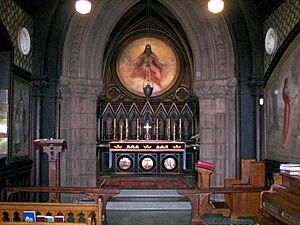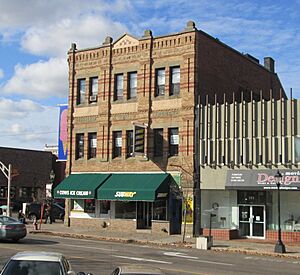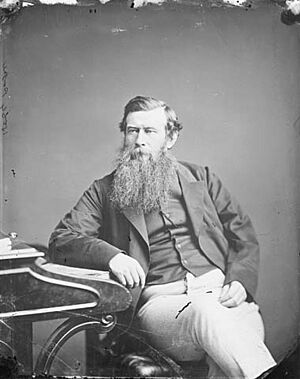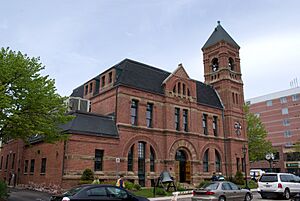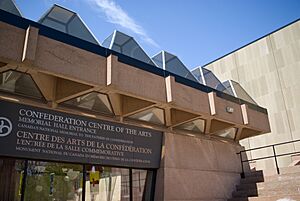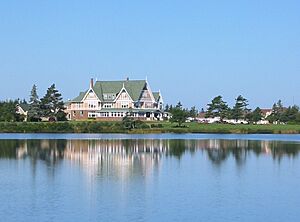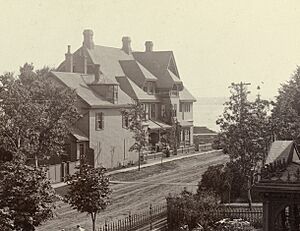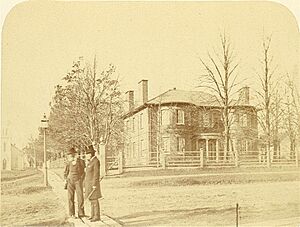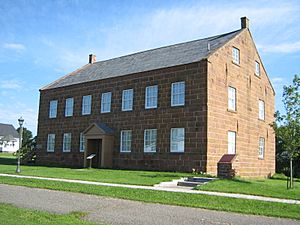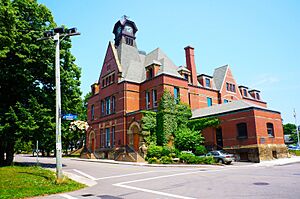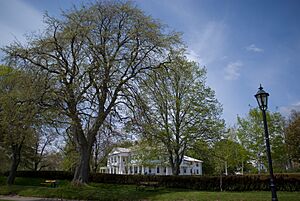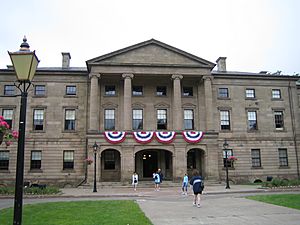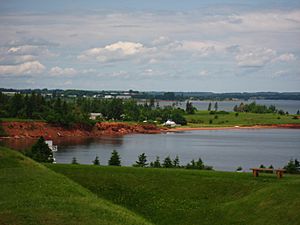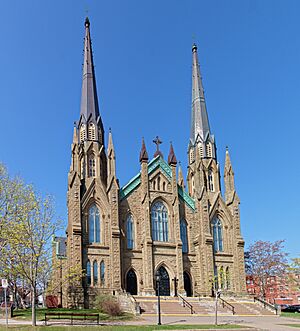List of National Historic Sites of Canada in Prince Edward Island facts for kids
Prince Edward Island is a beautiful province in Canada. It's also home to many special places called National Historic Sites. These sites are important because they tell us about Canada's history. There are 22 of these sites in Prince Edward Island. Some of them are looked after by Parks Canada, which is like a special team that takes care of Canada's natural and historic places. You'll see a little beaver icon ![]() next to the sites that Parks Canada manages. The very first National Historic Site in P.E.I. was Jean-Pierre Roma at Three Rivers, named way back in 1933.
next to the sites that Parks Canada manages. The very first National Historic Site in P.E.I. was Jean-Pierre Roma at Three Rivers, named way back in 1933.
Many other important historical events and people are also remembered across P.E.I. They are marked with special plaques, just like the National Historic Sites. These markers help us learn about Canada's rich past.
Contents
- Exploring Prince Edward Island's Historic Sites
- Alberton Court House
- All Souls' Chapel
- Apothecaries Hall
- Ardgowan
- Charlottetown City Hall
- Confederation Centre of the Arts
- Dalvay-by-the-Sea
- Dundas Terrace
- Fairholm
- Farmers' Bank of Rustico
- Former Summerside Post Office
- Government House
- Great George Street Historic District
- Jean-Pierre Roma at Three Rivers
- Kensington Railway Station
- L.M. Montgomery's Cavendish
- Province House
- Shaw's Hotel
- Skmaqn—Port-la-Joye—Fort Amherst
- St. Dunstan's Roman Catholic Basilica
- Strathgartney Homestead
- Tryon United Church
- See also
Exploring Prince Edward Island's Historic Sites
Alberton Court House
This old wooden building was finished in 1878. It was once a courthouse and is now a local museum in Alberton. It shows what early courthouses looked like in P.E.I.
All Souls' Chapel
Built in 1888, this small chapel is made of red Prince Edward Island sandstone. It's connected to St. Peter's Anglican Cathedral in Charlottetown. The chapel is famous for its beautiful design and 18 paintings inside by artist Robert Harris.
Apothecaries Hall
This three-storey brick building in Charlottetown was completed in 1900. It housed a pharmacy from 1810 all the way until 1986. This makes it one of the oldest pharmacies that operated continuously in Canada!
Ardgowan
![]() Ardgowan is a historic home in Charlottetown that was finished in 1850. It was the home of William Henry Pope, one of the important people known as the Fathers of Confederation. These leaders met at the Charlottetown Conference to discuss forming Canada. Pope hosted some of the delegates here during that important meeting.
Ardgowan is a historic home in Charlottetown that was finished in 1850. It was the home of William Henry Pope, one of the important people known as the Fathers of Confederation. These leaders met at the Charlottetown Conference to discuss forming Canada. Pope hosted some of the delegates here during that important meeting.
Charlottetown City Hall
Completed in 1888, this building in Charlottetown is the city's town hall. Its grand design shows how much Prince Edward Island and its capital city grew and became successful in the late 1800s.
Confederation Centre of the Arts
This large cultural center in Charlottetown was finished in 1964. It has a theatre, an art gallery, and a public library. It was built to remember the Fathers of Confederation who met in Charlottetown. It's a great example of the cultural buildings built across Canada in the 1960s and 70s.
Dalvay-by-the-Sea
![]() Located in Prince Edward Island National Park, this beautiful building was completed in 1899. It was built as a summer home for Alexander McDonald, who was the president of Standard Oil of Kentucky. Today, it's a hotel and a great example of a popular architectural style from that time called Queen Anne Revival.
Located in Prince Edward Island National Park, this beautiful building was completed in 1899. It was built as a summer home for Alexander McDonald, who was the president of Standard Oil of Kentucky. Today, it's a hotel and a great example of a popular architectural style from that time called Queen Anne Revival.
Dundas Terrace
This wooden apartment building in Charlottetown was finished in 1889. It has three and a half storeys. It's a notable example of the Queen Anne Revival style used for apartment buildings in Canada.
Fairholm
Fairholm is a brick house in Charlottetown that was completed in 1839. It was built for Thomas Heath Haviland, Sr. It's a rare and excellent example of a "Picturesque" style villa in Atlantic Canada.
Farmers' Bank of Rustico
This stone building in North Rustico was finished in 1863. It was one of the very first "people's banks" in Canada. It offered loans to farmers in the local community. This bank helped start the idea of credit unions in Canada.
Former Summerside Post Office
This stone building in Summerside was completed in 1887. It used to be a post office and is now the town hall. It shows the kind of post offices built in smaller towns across Canada during that time.
Government House
Completed in 1834, this is the official home of the Lieutenant Governor of Prince Edward Island in Charlottetown. It's a beautifully designed building in the neoclassical style, sitting on a large property called Fanningbank.
Great George Street Historic District
This historic area in Charlottetown was recognized in 1990. It's a wide street, six blocks long, that goes from the waterfront to Province House. Walking up Great George Street, you can imagine what the Fathers of Confederation saw when they arrived for the Charlottetown Conference in 1864.
Jean-Pierre Roma at Three Rivers
This site in Brudenell was established in 1732. Jean Pierre Roma set up a fishing and trading post here. It was later destroyed in 1745. This site is important because it shows the French presence on Île Saint-Jean, which is what Prince Edward Island was called back then.
Kensington Railway Station
This stone railway station in Kensington was completed in 1904. It was built for the Prince Edward Island Railway. It helps us remember how important railways were for developing the Maritimes region. It's also a rare example of an old railway station still standing in P.E.I.
L.M. Montgomery's Cavendish
![]() This special place near Cavendish was recognized in 2004. It's the area that author Lucy Maud Montgomery made famous in her beloved Anne of Green Gables books. It's like stepping into the world of Anne!
This special place near Cavendish was recognized in 2004. It's the area that author Lucy Maud Montgomery made famous in her beloved Anne of Green Gables books. It's like stepping into the world of Anne!
Province House
![]() Located in Charlottetown, Province House was completed in 1847. This beautiful building was the site of the Charlottetown Conference in 1864. This meeting was the very first step towards creating Canada as a country. It's a very important place in Canadian history.
Located in Charlottetown, Province House was completed in 1847. This beautiful building was the site of the Charlottetown Conference in 1864. This meeting was the very first step towards creating Canada as a country. It's a very important place in Canadian history.
Shaw's Hotel
Shaw's Hotel in Brackley Beach has a main lodge completed in 1860. It also has barns and cottages on a large property. This hotel has been a tourist resort for over 150 years. It helps us understand what early tourism in Canada was like.
Skmaqn—Port-la-Joye—Fort Amherst
![]() This hilly area in Rocky Point was established in 1720. It has the remains of an 18th-century fort first built by the French and later used by the British. This site was once the main government center and port for people coming to Île Saint-Jean (Prince Edward Island).
This hilly area in Rocky Point was established in 1720. It has the remains of an 18th-century fort first built by the French and later used by the British. This site was once the main government center and port for people coming to Île Saint-Jean (Prince Edward Island).
St. Dunstan's Roman Catholic Basilica
This grand church in Charlottetown was completed in 1907. St. Dunstan's is the main Roman Catholic church in Prince Edward Island. It was given the special title of "Basilica" in 1929. It's a great example of the High Victorian Gothic Revival style of architecture in Canada.
Strathgartney Homestead
Strathgartney Homestead in Bonshaw was completed in 1861. It's a part of what was once a very large estate owned by Robert Bruce Stewart. This site helps explain the old land system that was common in P.E.I. until the Land Purchase Act of 1875 changed things.
Tryon United Church
This wooden church in Tryon was finished in 1881. It was designed by William Critchlow Harris for a Methodist group. Now it's a United Church. It's an amazing example of the Gothic Revival style in Canadian architecture.
See also


